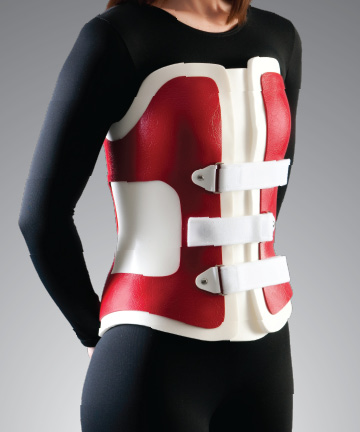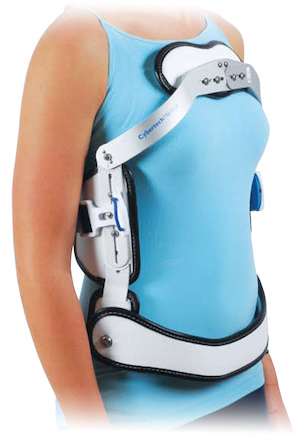Spinal Orthoses Custom and Custom Fit
Spinal orthoses are beneficial for treatment of many medical conditions and injuries.
 These conditions can be (but are not limited to):
These conditions can be (but are not limited to):
- Spine fracture
- Dislocation
- Post-operative
- Osteoarthritis
- Scoliosis
- Ankylosing Spondylitis
- Disc Herniation/prolapse
- Paraplegia
- Osteogenesis Imperfecta
- Fusion
- Osteoporosis
|
Anatomy and Biomechanics of the Spine |
The spine is made up of 7 cervical vertebrae, 12 thoracic vertebrae, 5 lumbar vertebrae, and the sacrum. There are many muscles, tendons, ligaments and nerves in spine. |
|
Goals of Spinal Orthosis Treatment |
|
|
Design of a Spinal Orthosis |
 A Certified Orthotist will assess the spine and take a 3-D cast/mould of the spine if needed. This can be performed with the patient in a prone position or in a standing position. The Certified Orthotist will ensure the spine is in a corrected position. A Certified Orthotist will assess the spine and take a 3-D cast/mould of the spine if needed. This can be performed with the patient in a prone position or in a standing position. The Certified Orthotist will ensure the spine is in a corrected position. There are a variety of spine brace designs. The Certified Orthotist will determine which design is best for treatment based on individual needs and goals. Spine braces will have some rigid components. All spine braces have straps to help ensure correct application of the orthosis .
|
|
Types of Spinal Orthoses |
|
| Spinal Orthosis Application |
Spinal orthoses work best when applied directly against the skin or with a thin undershirt. There are specific donning (application) instructions that the Certified Orthotist will explain to the patient. The Orthotist will also provide a wear schedule accompanied by cleaning and care recommendations. |
|
Living with a Spine Orthosis (follow up) |
The corrections provided by the spinal orthosis may take some time to get used to. The spinal orthosis should not be painful; however, it is not uncommon to some initial discomfort. The break-in period should not last more than two weeks. If you experience rubbing or blisters, please book an appointment with your Certified Orthotist for immediate attention. If you are experiencing pain after two weeks please book a follow up appointment with your Certified Orthotist. It is always recommended to book a follow up appointment with your Certified Orthotist if you experience any changes in condition (pain, change in size, growth). The Certified Orthotist can determine what changes need to be made or make recommendations for alternative treatment. Spinal orthoses can often be modified or refurbished. The Certified Orthotist can reassess to determine the course of treatment with you. |
|
Funding for Spine Orthosis |
Alberta Aids to Daily Living (AADL) does provide funding for custom spinal orthoses for Alberta Residents with valid Alberta Healthcare. AADL will pay 100% for the cost for Alberta Residents over the age of 65. AADL will pay 75% of the cost for Alberta Residents under the age of 65. A prescription from a physician is required. There is coverage for persons with low income.
|

